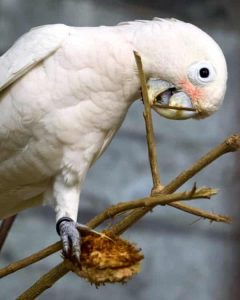
In the effort of living, humans have discovered that crafted tools were essential to making life better. With new tools, things that were difficult became easier. As time progressed, tool-crafting became more sophisticated to better achieve the desired result. That’s the extended history of mankind. Some animals have created tools to make their own lives easier.
People who study parrots and other exotic birds have found that they are able to exercise extraordinary talents in the mode of thought and execution. Recently, we’ve read of cockatoos in Australia teaching themselves the art of trash bin lid opening. The scientific community that centers on birds has closely observed many species, watching them find creative ways to do things.
Cockatoos Creative “Workarounds”
Aviary experts have long observed Goffin’s cockatoos working around problems to achieve an end. These cockatoos have been known to use cardboard strips as a tool to reach for food. They were able to modify the length of the strip if it was not long enough to do the job intended. Other methods of toolmaking and use of tools by these cockatoos have been witnessed and notated. Goffin’s Cockatoos are not habitual tool makers. But if something needs to be done, they don’t shy away from the task.
Recently, it was discovered by biology researchers that some Goffin’s cockatoos observed in the wild have created effective tools with which to eat. This study team works in the Tanimbar Goffin Lab, located in Indonesia, specifically on Yamdena Island within the Tanimbar Islands network. Their main study is the Goffin’s cockatoo, which is endemic to the islands. They keep tabs on the livelihood of the birds, their activities in the wild (and in captivity to better understand behaviors), and their population, which is NT (Near Threatened). The birds in captivity are eventually released to the wild after a time. But what they have been discovered doing this time is incredible.
A few years back, some researchers had found fruit on the ground that had been extracted by the cockatoos. The fruit was identified and brought back to the captive birds to watch their behavior on the extraction of seeds from the pit of the sea mango fruit. Clear access to the seeds within the pit is a difficult thing for birds. The researchers soon witnessed a cockatoo creating a tool with a small branch by making a wedge-shaped implement used to pry the pit open. It then fashioned a sharper tool to pierce the skin that housed the seeds. Then, the cockatoo formed a third tool that was used to make a spoon of sorts to scoop out the seeds to eat – the prize after all of that.
Only two of 15 captive cockatoos fashioned the sets of tools despite all being given the exact same setting. This pointed to the incredible intelligence of the birds who effectively used the tools to get to the seeds. But cockatoos are observant and mindful – as in the case of the Australian cockatoos with their developed lid opening skills. The likelihood that others may soon learn this skill set in the wild is strong as they have the intelligence to achieve it and a history of doing so. There has already been evidence of tool manufacture by cockatoos in the wild that has not been witnessed.
This tool-making study was written and published in Current Biology. What this study underscores is that this kind of tool-craft, once the exclusive practice of primates, is now known to be in the domain of birds as well. If you wish to investigate further, follow this link for the Current Biology journal entry along with an impressive video and detailed artwork.
I’m sure that those of you who have a Goffin’s cockatoo at home have your own amazing stories to tell of your bird’s abilities to make things happen.
